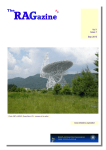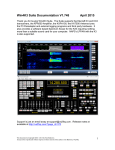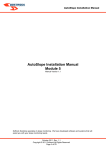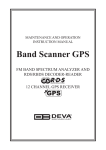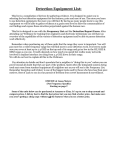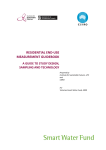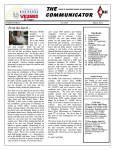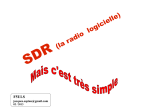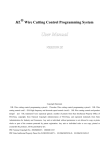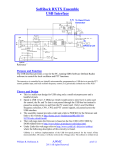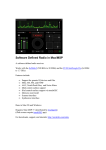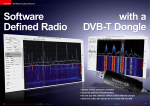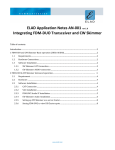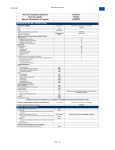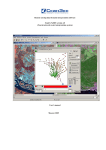Download January 2013 Issue - Oxley Region Amateur Radio Club
Transcript
First published 1980 Newsletter of the Oxley Region Amateur Radio Club Inc. PO Box 712 Port Macquarie 2444 Club Nets on VK2RPM 146.700MHz (CTCSS 91.5Hz) Every Sunday at 0830 Every Thursday at 1930 Club e-mail address: [email protected] Club Website: www.orarc.org ORARC’s Forty-second Anniversary Year January 2013 ORARC VHF/UHF Repeaters Compiled by VK2TT & VK2AYQ PRESIDENT: VICE PRES: TREASURER: SECRETARY: Henry Lundell VK2ZHE Bruce Walker VK2HOT Keith Anderson VKFKJA Henry Lundell VK2ZHE MIDDLE BROTHER VK2RPM 2 metre (Voice - CTCSS 91.5Hz) O/P 146.700MHz -I/P 146.100MHz 6582.0534 6583.8360 6586.3988 6582.0534 VK2RPM 70 cm (Voice - CTCSS 123Hz) O/P 438.525MHz -I/P 433.525MHz President’s Report VK2RPM-1 (APRS Digipeater) SX 145.175MHz 1200bps Welcome to 2013. I trust everyone has had a safe and enjoyable festive season. TELEGRAPH POINT VK2RCN 2 metre (Voice) O/P 147.000 MHz - I/P 146.400 MHz The ORARC 2013 Field Day takes place on Saturday the 8th and Sunday the 9th of June during the Queen’s Birthday Weekend. The Field Day venue will again be the Tacking Point Surf Life Saving Club building in Matthew Flinders Drive at Lighthouse Beach. Last year’s Field Day was a great success and this year’s event will be even bigger and better. VK2RCN 70 cm (Voice - CTCSS 123 Hz) O/P 438.425MHz - I/P 433.425MHz VK2RCN-1 (APRS Digipeater) SX 145.175MHz 1200bps Item. In This Issue : Page No. President’s Monthly Report Down the Coax E-Mail Directory Net Controllers’ Roster Calling Frequencies Christmas 2012 meeting Software Defined Radio New 630 meter band Planning for the 2013 Field Day will commence this month so please consider offering your assistance. The committee will be very pleased to hear from you. The club’s communications caravan was on display at the club’s Christmas barbeque at the Settlement Point reserve on Saturday the 1st of December 2012. The Christmas celebration was particularly enjoyable with an excellent attendance and perfect weather. Thank you to everyone who participated in the festivities, and a special thank you to the many people who assisted with the running of the day. Thank you to everyone who took photos and provided them to the editor for inclusion in this Don’t forget to join or renew your WIA membership. (Continued on page 3) http://www.wia.org.au/ 1 Front Cover 2 2 2 4 5 7 10 Net Controllers’ Roster Down The Coax Ross Hill Memorial Contest 1 to 31 January 2013 Monthly meetings held in the S.E.S. Building Central Road, Port Macquarie. Monthly Meeting Saturday 5 January 2013 2:00 pm Summer VHF-UHF Field Day Saturday 12 Sunday 13 January 2013 Friday Night Get-Together Friday 18 January 7.00 pm Nets on Voice Repeater VK2RPM 146.700 MHz Sundays (0830 Local) Thursdays (1930 Local) January 2013 VK2TT Jan - 06 VK2ZHE Jan - 03 VK2OA Jan - 13 VK2EM Jan - 10 VK2CHC Jan - 20 VK2ATM Jan - 17 VK2TT Jan - 27 VK2ZHE Jan - 24 VK2EM Jan - 31 February 2013 Monthly Meeting Saturday 2 February 2013 2:00 pm Friday Night Get-Together Friday 15 February 7.00 pm VK2OA Feb - 03 VK2ATM Feb - 07 VK2CHC Feb - 10 VK2ZHE Feb - 14 VK2TT Feb - 17 VK2EM Feb - 21 VK2OA Feb - 24 VK2ATM Feb - 28 March 2013 Wyong Field Day Wyong Racecourse Sunday 24 February 2013 Monthly General Meeting Saturday 2 March 2013 2:00 pm Friday Night Get-Together Friday 15 March 7.00 pm John Moyle Memorial Field Day Saturday 16 Sunday 17 March 2013 Bago Car Rally Saturday 23 March 2013 2 VK2CHC Mar - 03 VK2ZHE Mar - 07 VK2TT Mar - 10 VK2EM Mar - 14 VK2OA Mar - 17 VK2ATM Mar - 21 VK2CHC Mar - 24 VK2ZHE Mar - 28 VK2TT Mar - 31 (from page 1) Special thanks must go to and Arthur Monck VK2ATM and John VK2KC who sourced the hardware for the APRS trackers. Club members set up about 25 trackers during the year. If you have a tracker and haven’t used it for a while, why not plug it in and add to the many APRS tracks which appear daily in the Port Macquarie, Wauchope , Taree and Kempsey areas on APRS Google Maps http://aprs.fi/. To learn more about APRS visit the APRS Australian web site http://www.aprs.net.au/ issue of “Oxtales”. This time last year APRS was a major topic of discussion amongst club members after an inspirational lecture on the subject by Ashley Anderson VK2XSO at the club’s October monthly general meeting in 2011. APRS is short for Automatic Packet Reporting System. I am pleased to report that this discussion resulted in a great deal of practical construction which has made our area one of Australia’s APRS hotspots with two APRS digipeaters and a great many members fitting and using trackers in their vehicles. This year the club will continue to foster hands-on radio activities. One of these activities is to encourage experimentation in Software Defined Radio (SDR) techniques which is an excellent marriage of radio and computers. Many readers may have read about the FUNcube Pro + USB SDR dongle http:// www.funcubedongle.com/?page_id=1073 which covers 150 kHz to 1900 MHz. These come from the UK and cost about AUD$230 including international postage to Australia. These have a gap in coverage from 240 to 420 MHz so the coverage isn’t quite continuous. The good news is that no special drivers are required for Windows and Linux PCs. Also these units have built in RF front end filters and a temperature compensated crystal oscillator (TXCO) for good frequency accuracy. With free software such as SDRSharp http://sdrsharp.com/ all modes (AM, FM, USB, LSB, CW etc) can be received. The user manual indicates that the sensitivity on 2 meters is typically 12dB SINAD NBFM for 0.15uV at 145MHz. The FUNcube USB dongle was developed to encourage use of the FUNcube satellites as part of an AMSAT UK project. Ross VK2RR;, Arthur VK2ATM and John VK2FGAA at the VK2RPM Voice and APRS Repeaters. The club’s two 145.175 MHz APRS digipeaters are VK2RPM-1 at the VK2RPM repeater site at Middle Brother Mountain and VK2RCN-1 at the VK2RCN repeater site at Telegraph Point. Thank you to everyone who contributed to building, testing and installing these two digipeaters last year. They have proven to be a very important part of the overall national APRS infrastructure. They each digipeat some thousands of position packets from both local and transiting APRS trackers each month. However, it is possible to explore Software Defined Radio using cheap (less than $50) readily available DVB-T USB TV dongles and free software. http://www.vk6fh.com/vk6fh/SDRdongle.htm The down side is reduced frequency coverage (65 to 1700 MHz) and a gap in coverage between 1100 and 1250 MHz but there are lots of signals within the accessible frequency range. The DVB-T USB dongles lack the bandpass filters and some of the other features included in the FUNcube pro + USB dongles but they still offer very useable performance. Some readers may already have a suitable DVB-T USB dongle for their PCs. VK2RPM voice and APRS Repeaters The January 2013 issue of the ARRL journal QST (continued page 4) 3 (from page 3) CALLING FREQUENCIES contains an excellent article commencing on page 30 entitled “ Cheap and Easy SDR “ by Robert Nickels, W9RAN which explains how to obtain coverage from HF to 1700 MHz using a DVB-T USB dongle and a simple up converter for HF and 6 meters. Of course there is a wealth of information on the subject available on the internet. Closer to home, ORARC club member Bruce Ekert VK2EM has used modified Ku and C band LNBs in conjunction with a DVB-T USB dongle to build a microwave spectrum analyser as an aid to tuning up his microwave transverters . There are many commercially available sophisticated software defined receivers and transceivers such as the FlexRadio http://www.flex -radio.com/ . Many amateur transceivers already use the digital signal processing (DSP) techniques that are employed in pure SDR equipment. Hopefully this has whetted everyone’s appetite appetites. Please see the short article with several useful internet links to useful information which I have compiled for this issue of “Oxtales”. We look forward to arranging some talks and practical demonstrations of SDR at club meetings in the coming months. The club’s 2013 calendar is the most popular yet with photos of 68 of our members. Preparation of this year’s calendar represents a lot of detailed work on the part of John Hansen VK2AYQ. The annual calendar has become highly sought after for its member picture gallery and club information. Copies are still available and may be purchased at the January Friday night get together on the 18th of January, and at the Monthly General meeting on Saturday the 2nd of February 2013, and at subsequent meetings. The Mid North Coast Amateur Radio Group (MNCARG) has advised that there will not be a Radio Expo in Coffs Harbour in January 2013. Submitted by John VK2KC John has recently returned from a 2 month trip during which John had contact with other Radio Amateurs whilst ‘on the road’. John has compiled the following list of calling frequencies that club members may find useful either on trips or at home. Please note that these frequencies are used for providing clear channels for calling and one should QSY off the calling frequency once communications are established. Australian voice calling frequencies: 3.650, 7.090, 14.190, 21.190, 28.590, 52.160 World CW calling frequencies: 3.570, 7.030, 14.060, 18.080, 21.140, 24.910, 28.180, 50.160 World voice calling frequencies: 3.690 & 3.940 MHz, 7.090 & 7.190, 14.290, 18.140, 21.360, 24.960, 28.390, 50.160 Calling frequencies for Slow Scan TV (SSTV): 3.630, 7.033, 14.227 Calling Frequencies for PSK31 14.070 Members may care to add these frequencies to the diary’s, log books, smart phones and tablets for future use. The Central Coast Field Day at Wyong Racecourse is on Sunday the 24th of February 2013. The gates and the Flea Market open at 6:30am and the traders open at 9:00am. For more information see http:// www.fieldday.org.au/ Best wishes for a happy and healthy 2013. Jaycar is a major sponsor of our calendar. Only $2 from Henry VK2ZHE. Henry Lundell VK2ZHE President 4 Christmas Meeting The Club’s Christmas Meeting on Saturday 1 December at Settlement Point Park once again was a very enjoyable event. The weather smiled on us with a fine day and a cooling breeze to keep the heat at bay. The site is secured. Larry VK2CLL, Lewis VK2AG, Richard VK2CHC, and AlexVK2FOAB are ready for anything. Henry VK2ZHE ponders the meeting agenda! The cooks clean up. Keith VK2FKJA, Bill VK2ZCW and Richard VK2CHC. XYL’s keeping the group in line. Arthur VK2ATM and Neil VK2EI share a thought. 5 Keith VK2FKJA and John VK2KHJB reminisce. Dave VK2AYD enjoys the traditional ice cream and fruit salad.. Paul VK2UPR striding along to the meeting. A fine body of men Charles VK2KCE, John VK2AYQ and Mark VK2FMGM Tim VK2ZTM takes some time out. Coralie, Bill VK2ZCV, Dennis and Heather share a laugh. Yulia takes photos of the group. David VK2FRAB looks for provisions. 6 pass filter feeds these products to the audio amplifier which requires considerable gain in order to make the receiver sensitive enough for practical use. This technique avoids the need for converting the incoming signal to an Intermediate Frequency (IF) as is done in a conventional superheterodyne receiver. While there are disadvantages in this method it is often used in simple receivers for QRP and experimental use. Software Defined Radio (SDR) By Henry VK2ZHE Software Defined Radio (SDR) is the direction that radio receiving and transmitting technology is headed. Implementation of SDR radio still requires RF circuitry to receive incoming radio signals and to amplify generated radio frequency energy to a power level suitable for transmission. However, instead of using conventional RF filters to define received and transmitted RF bandwidth and to demodulate received signals and to modulate RF for transmission, these tasks are carried out by digital signal processing (DSP) techniques. The interface which gives the user control over these functions can be an interactive computer touch screen or a conventional computer display with a keyboard and mouse for input, or a conventional radio front panel with a display and buttons and knobs for control, all under control of an embedded computer. Of course the detector output of a direct conversion receiver contains more than just audio frequencies. All frequencies passed by the RF circuitry ahead of the mixer will beat with the local oscillator to produce sum and difference products extending up to many Megahertz if the front end filter is wide enough. In fact in a conventional superheterodyne receiver the IF amplifier simply passes a small band of frequencies in this spectrum and amplifies and filters this energy before demodulating it in typically a simple diode envelope detector for AM signals or a mixing the energy with a beat frequency oscillator (BFO) in a product detector to detect AM or SSB signals. In this example the secret to hearing a desired signal is that the difference in frequency between the desired signal and the oscillator used to mix with the incoming RF must be equal to the intermediate frequency. There are many commercially available sophisticated software defined receivers and transceivers such as the FlexRadio http://www.flexradio.com/ . One type of Software Defined Radio (SDR) receiver makes use of the relatively wide band of frequencies available at the output of a direct conversion receiver. The output of the receiver is first digitally sampled by an analogue to digital (A to D) converter. The bandwidth i.e. the range of frequencies sampled is dependent upon the speed of the clock used to make the samples, and upon the number of digital bits in each sample i.e. the resolution of each sample. This sampling is done in quadrature giving two data streams known as the I and Q streams which are able to be digitally manipulated under software control to select and detect a desired signal. One common method for experimenters to achieve this is to feed the I and Q outputs of a direct conversion receiver into a computer stereo sound card. To obtain the quadrature I and Q streams the direct conversion receiver uses a local oscillator with two outputs 90 degrees apart. Software freely available for download from the internet is then used to perform all the Software Defined Radio (SDR) receiver digital signal processing (DSP) functions necessary to receive incoming digital and analogue signals transmitted in virtually any mode. A popular example of this technique is the SoftRock series of kits. As a bonus Many current model amateur transceivers already use the same digital signal processing (DSP) techniques that are employed in pure SDR equipment. There have many articles published over the last decade describing methods for affordably experimenting with software defined radio. It is possible to build a homebrew RF interface to connect to a sound card to enable a home computer to be used with free software to receive radio signals. Similarly, there are various kits and ready-built interfaces available. Many Amateurs will be aware of direct conversion receivers which use an oscillator on, or close to the same frequency as an incoming signal to mix with the incoming signal to directly produce a heterodyne at audio frequencies. A simple audio band- (Continued page 8) 7 (from page7) the SoftRock kits include a complete 1 Watt HF transceiver kit, the Ensemble RXTX Project http:// www.wb5rvz.com/sdr/ensemble/ for which current information may be found at http:// www.wb5rvz.org/ensemble_rxtx/index? projectId=14 and kit pricing at http://fivedash.com/ for les than US$100. A representation of the kit available in various models One of the big advantages of Software Defined Radio (SDR) implementation as described above is that within the limitations of the sound card a spectrum of up to 96 kHz is available on the receiver display. Those who have used one of the many digital software programs such as Digipan http://wb8nut.com/digital/ for PSK31 will be familiar with the waterfall display of frequency versus time. DVB-T USB dongles are suitable. A partial list of known suitable dongles may be found at http:// sdr.osmocom.org/trac/wiki/rtl-sdr The suitable DVB-T USB dongles use the Realtek RTL2832U chip which enables the raw I/Q quadrature samples to be transferred to the host computer. Dongles which pair the Realtek chip with the Elonics E4000 chip cover the frequency range of 64 to 1700 MHz with a gap from 1100 to 1250 MHz. Since dongles which use the Realtek chip perform the task of extracting the I/Q digital data within the dongle and do so much faster than is possible with an external sound card, an SDR receiver using one of these dongles can display a spectrum of up to 2 MHz wide. The January 2013 issue of the ARRL journal QST http://www.arrl.org/files/file/QST/ ThisMonthinQST/January2013/TOC.pdf contains an excellent article commencing on page 30 entitled “Cheap and Easy SDR“ by Robert Nickels, W9RAN which explains how to obtain coverage from HF to 1700 MHz using a DVB-T USB dongle and a simple up converter for HF and 6 metres. Of course there is a wealth of information on the subject available on the internet. As I mentioned in my President’s Report, ORARC club member Bruce Ekert VK2EM has used modified Ku and C band LNBs in conjunction with a DVB-T USB dongle to build a microwave spectrum analyser as an aid to tuning up his microwave transverters http://www.vklogger.com/forum/ viewtopic.php?f=23&t=10527#p24765 . The advent of terrestrial Digital Television Broadcasting (DVB-T) has created a mass market for USB dongles to enable digital television to be received on home PCs. Astute amateurs discovered that some of the cheap popular DVB-T USB dongles contained everything required to make an SDR VHF/UHF receiver simply by plugging the dongle into a PC and running suitable free software:http://www.vk6fh.com/vk6fh/ SDRdongle.htm These provide frequency coverage (65 to 1700 MHz) with a gap in coverage between 1100 and 1250 MHz. Some readers may already have a suitable DVB-T USB dongle for their PCs. Not all 8 Many readers may have read about the FUNcube Pro + USB SDR dongle http:// www.funcubedongle.com/?page_id=1073 which covers 150 kHz to 1700 MHz. These come from the UK and cost about AUD$230 including international postage to Australia. These have a gap in (Continued page 9) (Continued from page 8) folder/d/0B98akUlPIomlRGxjVElDNDJqaW8/ edit?pli=1 W9RAN SDR Sharp User Guide http:// www.goo.gl/suS2w VK2EM SDR posting http://www.vklogger.com/ forum/viewtopic.php?f=23&t=10527#p24765 FUNcube web site http://www.funcubedongle.com/ SDR Radio FUNcube support http://www.sdrradio.com/Software/FUNcubeDongle/tabid/475/ language/en-GB/Default.aspx SoftRock WB5RVZ Software Defined Radio Homepage http://wb5rvz.com/sdr/ SoftRock principle explained http:// softrocksdr.wikispaces.com/How+Softrocks+Work Ensemble RXTX Project http://www.wb5rvz.com/ sdr/ensemble/ Current Ensemble TXRX Project information http://www.wb5rvz.org/ensemble_rxtx/index? projectId=14 SoftRock Kit Supplier http://fivedash.com/ SoftRock Ensemble SDR Tx/Rx kit http:// fivedash.com/index.php? main_page=product_info&cPath=1&products_id=7 &zenid=1bc1905ac9b8cad7e12d4f4d1c5edb27 WB8NUT Digital Modes Information Page http:// wb8nut.com/digital/ FlexRadio http://www.flex-radio.com/ coverage from 240 to 420 MHz so the coverage isn’t quite continuous. The good news is that no special drivers are required for Windows and Linux PCs. Also these units have built in RF front end filters and a temperature compensated crystal oscillator (TXCO) for good frequency accuracy. With free software such as SDRSharp http:// sdrsharp.com/ all modes (AM, FM, USB, LSB, CW etc) can be received. The user manual indicates that the sensitivity on 2 metres is typically 12dB SINAD NBFM for 0.15uV at 145MHz. The FUNcube USB dongle was developed to encourage use of the FUNcube satellites as part of an AMSAT UK project. Henry VK2ZHE This article barely scratches the surface of SDR. It is hoped to run a series of talks and demonstrations on the subject at ORARC club meetings during 2013. Offers to share your knowledge and experience with fellow members will be greatly appreciated. Please contact the Committee at any time. Henry Lundell VK2ZHE Below are links to some sites which will be of interest: VK6FH SDR page http://www.vk6fh.com/vk6fh/ SDRdongle.htm Partial list of compatible DBV-T Devices http:// sdr.osmocom.org/trac/wiki/rtl-sdr SDR Sharp website http://www.sdrsharp.com/ SDR Sharp Download Page http:// www.sdrsharp.com/index.php/downloads RTL2832 DVB-T Dongle Installation http:// rtlsdr.org/softwarewindows SDR Sharp Yahoo Group http:// uk.groups.yahoo.com/group/SDRSharp/ W9RAN SDR Info https://docs.google.com/ 9 with Morsecodians who for a small fee will send “Telegrams”. New 630 meter band Date : 01 / 01 / 2013 Author : Peter Young - VK3MV From WIA Website ACMA Makes Amendments to the Amateur Licence Conditions Determination (LCD) – The new 630 meter band is now a reality. Effective from the 1st January 2013, Australian Advanced amateur licensees can now operate in the new band (630 meters) on a secondary basis. This new world wide allocation from 472 kHz to 479 kHz is an outcome of the ITU World Radio Conference in 2012 (WRC-12). The ACMA has amended the conditions in the LCD that gives effect to the WRC outcomes authorising a radiated power of not more than 5 watts pX EIRP, with a maximum emission bandwidth of 2.1 kHz. There is however two exclusion zones where amateur operation is not permitted so as to protect aeronautical nondirectional beacons (NDB) operating in the Exmouth and Timor regions. Also included in the amendments is the withdrawal for general use by advanced licensees to the amateur secondary allocation, 420 to 430 MHz to allow for greater harmonisation of government services in the 400 MHz band, following the ACMA’s review of this band. The use of this segment by amateurs was mainly for fixed links associated with repeater interlinking and a number of ATV channels where alternative channel assignment have been achieved in the 430 to 450 MHz 70cm band. The Beechworth Telegraph Station The telegrams are sent via a ‘bug’ or straight key which is connected to a telephone line via a modem. A Morse operator establishes a contact with a receiving station and the ‘telegram’ is sent. The sending and receiving stations are staffed by volunteers and are dotted around Australia. The receiving operator types the received message onto a facsimile of an old telegraph form and the message is delivered to the recipient by post. Telegram that is filled out and presented to the operator. The operator at Beechworth was Leo Nettle who had been a Post Office telegraph operator and really swung the old mechanical bug and straight keys Although Leo was only sending at around 25 words per minute I couldn’t read the Morse on the sounder receiver as the operator ‘reads’ the spaces between the sound clicks. He said that he was able to read both what he called ‘radio Morse’ and Post Office Morse without any trouble however some people apparently never get the hang of Post Office Morse. By John VK2AYQ Whilst travelling through Victoria in June 2012 I came across the Beechworth Telegraph Station. The building is made up of beautifully restored sandstone situated in the Beechworth Historic and Cultural Precinct. I was excited to find that inside there is a functional replica of the actual Telegraph station complete Leo sending a telegram using the straight key. (continued page 11) 10 (from page 10) the building was again remodelled with the addition of a large office fronting Ford Street and the remaining rooms to the rear became the residential accommodation for the District Surveyor. There was even a local connections with our club. Trevor VK2TT was one of the people who had designed and set up the network and modems. The building was last used as the Beechworth Office of the Department of Natural Resources and Environment until 1999, renovated and re-opened as part of the Historic Precinct in October 2001. People were fascinated watching Leo sending and receiving messages and it was a really great way to understand one aspect of our communication history. I would thoroughly recommend a visit to the Telegraph Office and indeed Beechworth with its collection of Historic Buildings. I sent Henry VK2ZHE a telegram asking him to give my apologies to the next meeting. Message as received by Henry. The Morse Sounder, sidewinder mechanical bug and straight key used to send Telegraphic messages (From the Beechworth Telegraph Office display). Beechworth Telegraph Station a brief overview reprinted from the information brochure of the Historic and Cultural Precinct. ...The Electric Telegraph Wire snaked its way across country to Beechworth in late 1857. By 1858, this modern wonder of communication was housed in the Telegraph Station next to the Court House. Early illustrations show it as a single storey building set back from the street in line with its neighbours. The double fronted façade had a central entrance featuring a two storey tower using a sliding ball to indicate the time. Beechworth marvelled at the onset of instant communications between itself, Melbourne and Sydney and eventually the rest of Australia and the world. The telegraph proved a great boon for business and government officials and of course it was highly valued for personal messages. Who thinks that SMS and text messaging is a new concept? I came across the above in the historical display of a comment written in January 1901. The postal and telegraph departments were combined in 1869 and the telegraph function was probably transferred to the post office around that time. The Telegraph Station Manager was promoted to Postmaster in December 1870. In 1871, The ideas were there even if it took many years for the technology to be developed. 11











